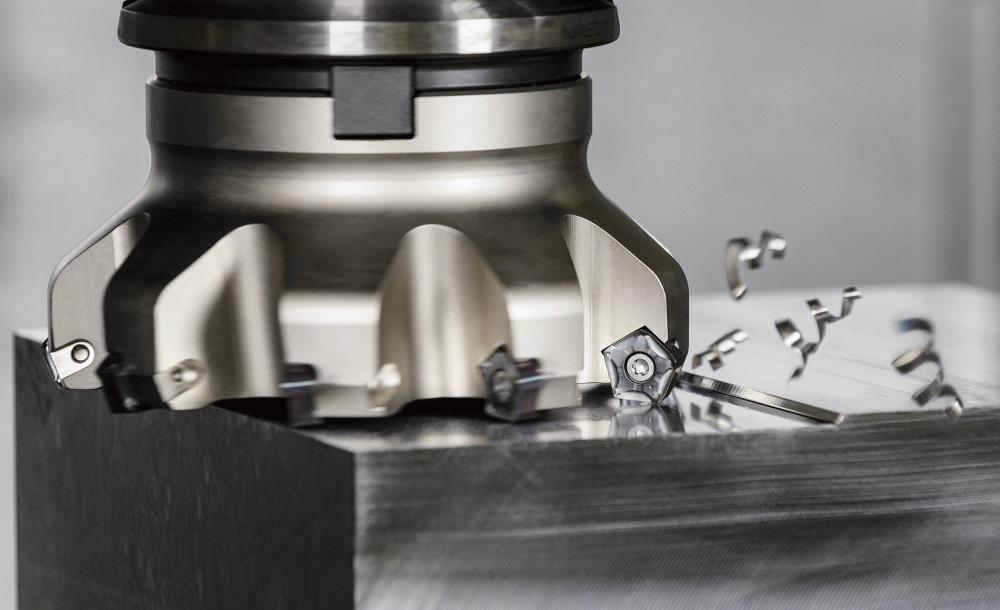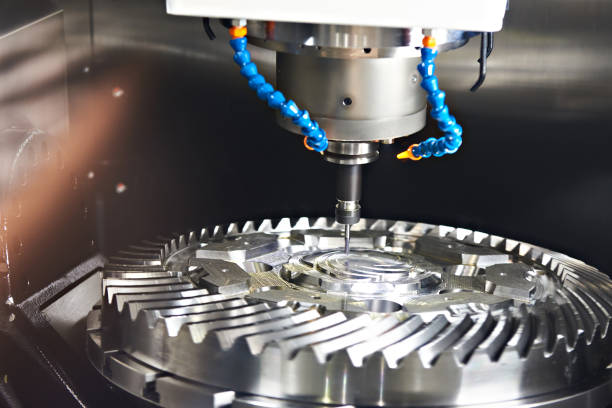Milling is a process for the detailed and accurate shaping of work pieces. This process holds an important place in the manufacturing industry. Slab milling and face milling are the two most impressive and useful methods when it comes to milling techniques as they both offer unique and multiple advantages. The integration of CNC (Computer Numerical Control) machines has transformed milling operations in the recent times which has led to an enhancement in precision and efficiency. Here, we are going to explore the differences between slab milling and face milling, with a special focus on their application with CNC machines.
Slab milling is a machining process primarily used to remove material from the surface of a workpiece. It involves the use of a cylindrical cutter with multiple teeth, known as a slab mill or shell mill. The cutter is mounted on an arbor and is oriented parallel to the workpiece's surface. As the cutter rotates, it creates chips by cutting into the material. Slab milling is highly versatile and can be used for various applications, including creating contoured surfaces, slots, and pockets.
One of the critical aspects of slab milling is the cutter's geometry, which determines the type of cuts it can make. Slab mills come in different configurations, such as single- and multiple-insert cutters. The choice of cutter depends on factors like material type, desired surface finish, and machining requirements.
Face milling, on the other hand, is a machining technique employed to create a flat surface on the workpiece. In face milling, a flat-bottomed cutter, often referred to as a face mill, is used. This cutter has teeth on its periphery and bottom, allowing it to both face and edge mill. The cutter is mounted on an arbor, similar to slab milling, but its orientation is perpendicular to the workpiece's surface.
Face milling is highly effective for achieving perfectly flat surfaces with precise edge milling. It is commonly used for squaring up blocks of material, milling large flat surfaces, and producing workpieces with perpendicular faces.
CNC Machines: The Precision Revolution
CNC machines have transformed the milling landscape by offering unparalleled precision, repeatability, and automation. These machines are programmed using computer software to precisely control tool movements, speeds, and feeds. When it comes to slab milling and face milling, CNC machines take these processes to the next level.

When employing a CNC machine for slab milling, the operator can program the toolpath with exceptional precision. This level of control allows for intricate cuts, smooth surface finishes, and the ability to machine complex geometries with ease. CNC slab milling is ideal for creating contoured surfaces, slots, and pockets with high precision.
CNC machines can follow intricate toolpaths, allowing for the creation of complex shapes and contours with high precision. This level of control ensures that the final workpiece meets the most stringent quality standards.
CNC machines can automatically change cutting tools based on the programmed instructions. This feature enhances efficiency and reduces downtime, as different tools can be used in a single machining operation without manual intervention.
CNC machines can be programmed to optimize cutting speeds and feeds for achieving superior surface finishes. This is particularly crucial when machining materials that require a smooth and pristine surface, such as aerospace components.
CNC face milling ensures that the cutter follows the programmed path with unmatched accuracy. This results in perfectly flat surfaces and precise edge milling. Additionally, CNC machines can be programmed to adjust tool height, making it possible to create stepped or contoured faces with ease.
CNC-controlled face milling ensures that the finished surface is perfectly flat, meeting strict flatness requirements often necessary in precision engineering and manufacturing.
CNC machines can execute intricate face milling operations, such as creating stepped faces or contoured surfaces. This capability expands the range of workpieces that can be produced with precision.
CNC machines automate the face milling process, leading to higher efficiency and reduced reliance on operator skill. This is particularly advantageous when producing large quantities of work pieces with consistent quality.
To better understand which technique to use with CNC machines, it's essential to highlight their key differences:
· Slab Milling: The cutter is oriented parallel to the workpiece's surface.
· Face Milling: The cutter is oriented perpendicular to the workpiece's surface.
The orientation of the cutter is the most fundamental distinction between these two milling techniques and significantly influences the type of machining they are suited for.
· Slab Milling: Produces contoured surfaces and intricate shapes with smooth finishes.
· Face Milling: Yields perfectly flat surfaces with precise edge milling.
The desired surface finish of the workpiece is a crucial factor in choosing between slab milling and face milling. Slab milling excels at creating complex contours, while face milling excels at producing flat and precise surfaces.
· Slab Milling: Efficiently removes material from the workpiece's surface.
· Face Milling: Creates flat surfaces by removing material evenly across the entire face.
The manner in which material is removed differs significantly between the two techniques. Slab milling focuses on removing material from the surface, while face milling evenly shaves material to create a flat surface.
· Slab Milling: Ideal for sculpting and shaping workpieces with complex surface requirements.
· Face Milling: Primarily used for achieving flat and perpendicular surfaces.
The choice between slab milling and face milling depends on the specific requirements of the project. Slab milling is chosen when intricate shapes and contours are needed, while face milling is preferred when flatness and perpendicularity are critical.
· Slab Milling: Employs slab mills or shell mills.
· Face Milling: Utilizes face mills with flat-bottomed geometry.
The type of cutter used is another significant difference. Slab mills are cylindrical with teeth on the periphery, while face mills have both peripheral and bottom teeth for flat-bottomed cutting.
CNC machines offer several advantages that make them the preferred choice for modern milling operations:
CNC machines ensure consistent and accurate results, irrespective of operator skill level. The programmed toolpaths and automated movements guarantee precision in every cut.
Automation and CNC control lead to faster machining times and increased productivity. CNC machines can operate continuously, reducing downtime associated with manual tool changes and adjustments.
CNC machines can seamlessly switch between slab milling and face milling operations, expanding their capabilities. This versatility allows manufacturers to tackle a wide range of projects without the need for multiple specialized machines.
CNC machines can optimize cutting parameters, including spindle speed and feed rate, to achieve superior surface finishes. This is particularly important when machining materials that require exceptional smoothness, such as components for the medical or optical industries.
One of the most significant advantages of CNC machines is their repeatability. Once a program is created and tested, the CNC machine can produce identical parts or components repeatedly without deviations. This consistency is essential in industries where precision and quality control are paramount, such as aerospace, automotive, and medical device manufacturing.

The decision between slab milling and face milling, even with CNC capabilities, ultimately hinges on the specific requirements of the project at hand. To make an informed choice, consider the following factors:
The geometry of the workpiece is a critical determinant. If the workpiece requires intricate contours or irregular shapes, slab milling may be the preferred choice. On the other hand, if the goal is to achieve flat surfaces, especially perpendicular faces, face milling is the logical selection.
Consider the desired surface finish of the workpiece. Slab milling can deliver smoother, contoured surfaces suitable for artistic or decorative components. In contrast, face milling excels at providing exceptionally flat and smooth surfaces, meeting strict tolerances and quality standards.
The type of material being machined plays a significant role in choosing the technique. Some materials, such as aluminum and plastics, may be more suited for slab milling due to their ease of machining and low cutting forces. Conversely, harder materials like steel or exotic alloys may benefit from face milling's capacity to evenly remove material.
Consider the production requirements and efficiency goals. Slab milling can be efficient for creating complex shapes but may take longer to achieve the desired surface finish. Face milling, with its ability to rapidly produce flat surfaces, is often preferred for high-volume production.
Leverage the capabilities of your CNC machine. Many modern CNC machines are equipped with multiple axes and tool changers, allowing for greater flexibility. Ensure that your machine's features align with the chosen milling technique and the specific demands of your project.
To illustrate the practical use of slab milling and face milling with CNC machines, let's explore real-world applications for each technique:
In the aerospace industry, precision and reliability are non-negotiable. Slab milling with CNC machines is commonly employed to craft intricate components, such as engine turbine blades. The ability to create complex airfoil shapes with smooth surfaces is essential for optimal aerodynamic performance. CNC-controlled slab milling ensures that each blade meets exact specifications, contributing to the efficiency and safety of aircraft.
The automotive industry relies on face milling with CNC machines to produce engine blocks with precision. These engine blocks require perfectly flat mating surfaces for gasket sealing and optimal engine performance. CNC face milling machines can rapidly achieve the desired flatness and finish, ensuring that every engine block meets the strict quality standards of the automotive industry.
As technology continues to advance, CNC milling is not immune to innovation. Here are some future trends and developments to watch for in the CNC milling landscape:
AI-driven algorithms can optimize toolpath planning, cutting parameters, and tool selection. This integration enhances efficiency, reduces cycle times, and minimizes tool wear, ultimately leading to cost savings and improved machining outcomes.
CNC machines are becoming more autonomous, with the ability to perform tool changes, tool offsets, and part inspection automatically. This trend will further reduce the need for manual intervention and enhance overall productivity.
Advancements in sensor technology and real-time monitoring systems will enable CNC machines to detect minute deviations and make adjustments on the fly. This will contribute to higher machining accuracy and improved quality control.
The development of multi-tasking CNC machines that can perform various machining operations in a single setup will continue to gain traction. These machines can streamline production processes, reduce lead times, and save on floor space.
Environmental concerns are driving the development of eco-friendly machining techniques. CNC milling machines are being designed with energy-efficient features and coolant recycling systems to minimize their ecological footprint.
Both slab milling and face milling have their own unique place in the manufacturing and machining industry. When integrated with CNC machines, these techniques reach higher levels of precision and productivity. Whether to choose slab milling or face milling depends on what is needed in the project and multiple factors like work piece geometry, type of material, and surface finish play a crucial role in taking that decision.
CNC technology empowers manufacturers to execute these techniques with exact precision, to make sure that the end result meets the highest quality standards. The advancement in CNC machines is going to be more and more useful for precision engineering and manufacturing. The incorporation of AI, increased automation, enhanced monitoring, multi-tasking machines, and sustainability initiatives will continue to shape the landscape of CNC milling, driving efficiency, sustainability, and innovation in the manufacturing industry.